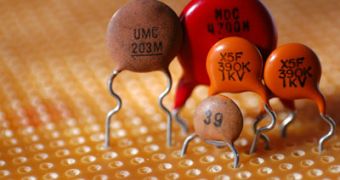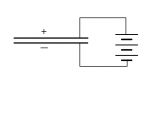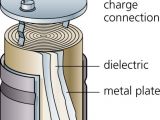Capacitors are similar in a way to batteries, but have different construction and characteristics. They store electric energy and release it when necessary; but unlike batteries, capacitors can be charged and discharged with a much higher frequency and may experience multiple charge-discharge cycles during operation. However, capacitors have one great disadvantage compared to batteries: they cannot retain electric energy for long periods of time.
Of all electronic components, aside from resistors, the construction of capacitors is one of the most simple. Basically they consist of two metallic plates brought in close proximity and isolated from one another with a dielectric substance, such as air, paper, mica, Teflon and others. The type of material used as dielectric depends on the application. For example, some dielectric material may behave well under high voltages and frequencies but may fail to work at ultra frequencies and low voltages.
You can easily identify the symbol of the capacitor in electronic schematics, as it is represented by two parallel lines connected in the electronic circuit through terminals attached to each other. Capacitors may be polarized or non-polarized, meaning that the terminals are either positive or negative and must be connected in the electronic circuit accordingly.
How it works
When capacitors are connected in parallel with a battery, electric charge from the negative terminal of the battery travels to the negative terminal of the capacitor where it is accepted. On the other hand, the positive terminal of the capacitor loses electrons which travel to the positive terminal of the battery. Although the electric charge is not stored instantaneously, the process is much faster than the charging process of a battery, or of an accumulator.
The bigger the common surface area between the two metallic plates, the higher the charge that can be stored inside a capacitor, so in the end capacitors may store enormous amounts of electric energy. When the electric charge stored inside a capacitor needs to be used, they are connected in electronic circuits in the same way as the batteries. Again, a big advantage/disadvantage - according to applications - opposed to batteries is that although they can accumulate large amounts of energy in a relatively small amount of time, they release it just as quick.
Capacitance
The storing volume of capacitors is measured in units called farads. One farad represents the capacitance of this device which, when posed with a potential difference of one volt between its terminals, is able to retain an electrical charge of one coulomb. One coulomb is the charge of 6.25 billion electrons, which means that a capacitor of one farad can store a massive amount of energy.
For example, the energy held by a single standard alkaline AA battery is about 2.8 ampere-hour. It would take about 10,080 farads to hold the same amount of energy. Personally, I've never heard of such a big capacitor, but I believe it would be as big as a house or so.
Uses
Capacitors have a broad range of uses, all the way from stabilizing DC voltage carrier lines to storing high amounts of energy for high-speed use when needed and making alternating current flow while direct current is being blocked. You can find them mostly anywhere; if there's an electronic device in your vicinity, most certainly it contains several tens or thousands of capacitors.

 14 DAY TRIAL //
14 DAY TRIAL // 

